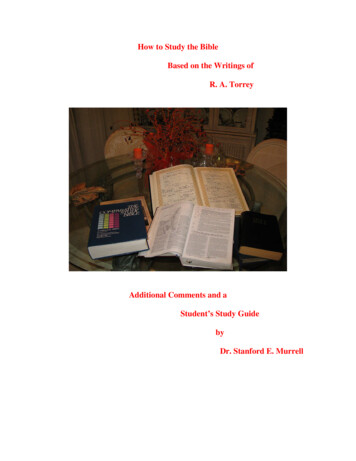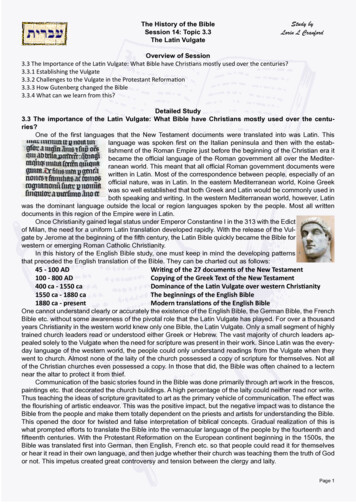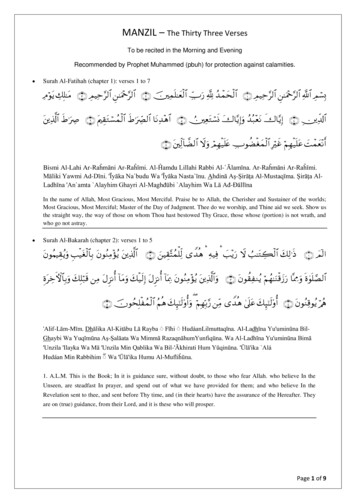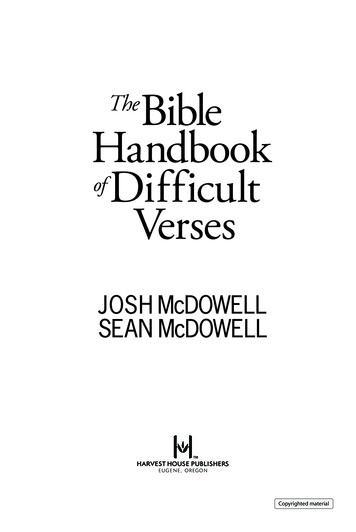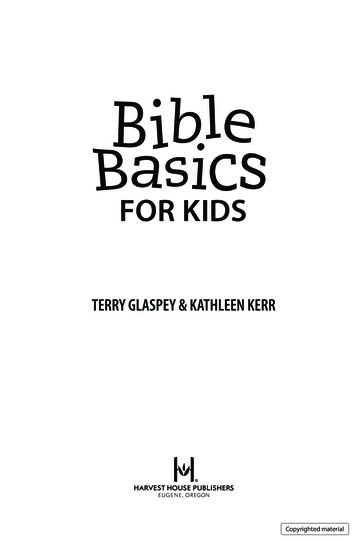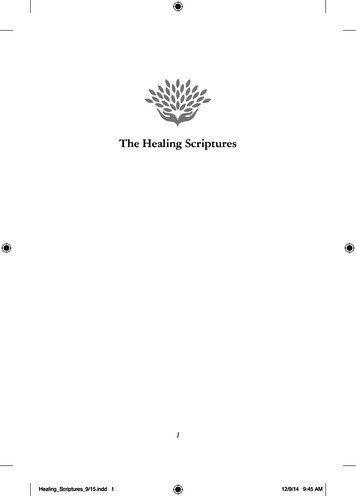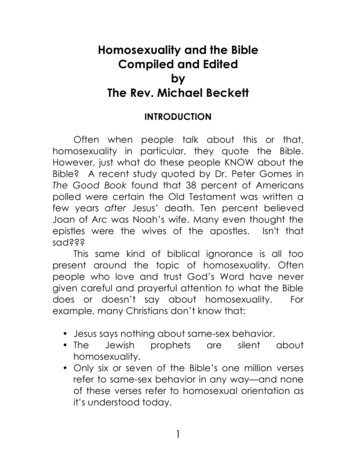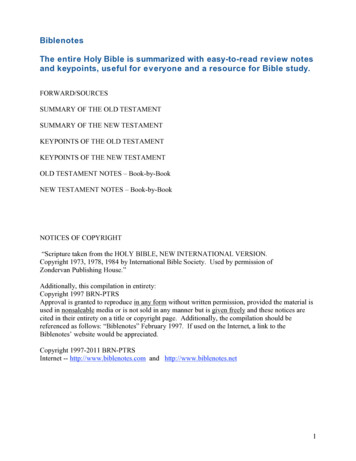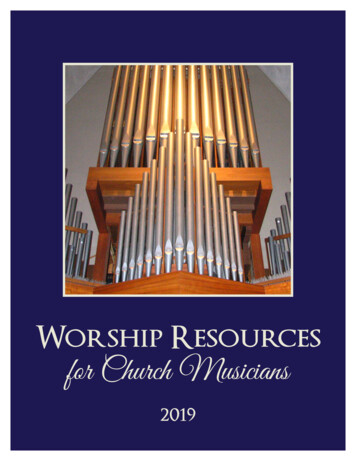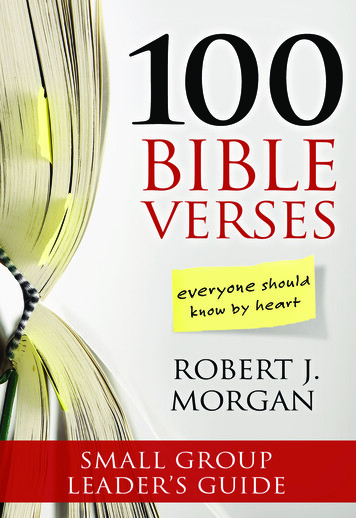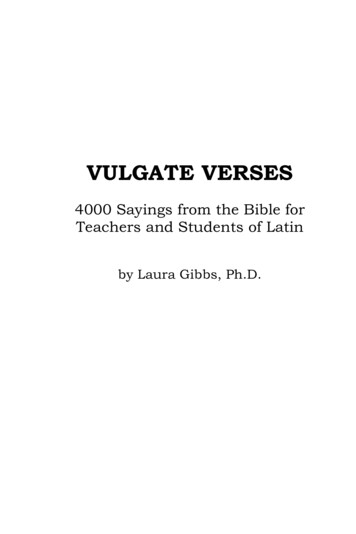
Transcription
VULGATE VERSES4000 Sayings from the Bible forTeachers and Students of Latinby Laura Gibbs, Ph.D.
Published byLulu Publishers860 Aviation ParkwayMorrisville, NC 27560(919) 459-5858www.lulu.com 2007 Laura Gibbs. All rights reserved.This book is part of Bestiaria Latina, a collection ofonline and printed Latin language teaching materials.For more information, visit the website:www.bestlatin.net
Post industriam sequitur sapientia.
VULGATE VERSESThis book and its companion website, BibliaVulgata.com,are designed to help you study Latin using the Vulgate Bible.Like my earlier book, Latin Via Proverbs: 4000 Proverbsfor Students of Latin (also available from Lulu Publishers),this book is organized according to grammatical categories.This method allows you to find easy-to-read Bible verses (orparts of verses) which are suited to your level of Latin,whether you are a beginning or an intermediate student.Beginning Latin students. If you are a beginning Latinstudent, do not try to work through this book from start tofinish. Rather than follow this book’s order, you shouldfollow the order in which the nouns and verbs are presentedin your textbook, using the Table of Contents in this book tofind the specific groups of verses that match the nouns andverbs you are studying.Intermediate Latin students. If you are an intermediateLatin student who already has completed a course in Latin,you can use this book as a systematic review of Latingrammar. You either can work through this book from startto finish, or you can focus on the specific categories of Latinnouns and verbs that you most want to practice.Latin Via Proverbs. An excellent way to use this book is inconjunction with the Latin proverbs and sayings collected inLatin Via Proverbs: 4000 Proverbs for Students of Latin.These two books complement each other very nicely becauseof the types of grammatical constructions that arecharacteristic of proverbs, as opposed to the types ofconstructions most commonly found in the Biblical text.Latin Via Proverbs is especially strong on present tenseverb forms, but weak on the perfect verb system. VulgateVerses, on the other hand, is especially strong on the perfectverb system. By working with both books together, you canget a solid overview of the entire range of Latin verb forms.i
PrefaceLearning Latin Through Bible VersesThere are many reasons why reading these verses is an idealway to practice your Latin. First and foremost: the verses areshort! Take the first verse in the book, for example: Clara estsapientia, “Wisdom is splendid.” Just three little words!There are over one thousand verses in this book which arefive words or fewer in length. So, even if you have to look upevery word in a verse, that is still not very many words tolook up.Another great advantage of Bible verses is that they meansomething; in fact, they may be deeply meaningful for you,unlike the typical practice sentences you might find in yourLatin textbook. This holds true both for persons who arebelievers in God and those people who are simply curiousabout the cultural traditions of Judaism and Christianity. Ifyou are a believer, you will find many verses here which maybe among your personal favorite verses, or verses whoseimagery figures in your favorite hymns or prayers. If you areinterested in the cultural history of the Bible, you will find inthese verses the text of the Vulgate Latin Bible that inspiredSaint Augustine and Saint Francis, Chaucer and Dante,Thomas More and Thomas Merton, to name only a few.Although I have entitled this book Vulgate Verses, many ofthe items you will find here are not complete verses, butpartial verses. In fact, the verse divisions of the Bible are acomparatively modern invention. The “Geneva Bible,”published in 1560, was the first English Bible to use versenumbers. In this book, I have made use of the conventionalverse numbering in order to help you locate the verses in theBible, but I have also felt free to use partial verses wheneverthat suited the pedagogical purposes of this book. You willalso find verses used more than once, with increasingly morecomplete forms of the verse found as the book progresses.Most of the items are stand-alone phrases whose meaning isclear, independent of context. For example, the phraseOmnes filii Dei estis, “You are all children of God,” can beii
Prefaceunderstood on its own, without looking up the context of theverse in Paul’s Letter to the Galatians. I have tried to makesure, whenever possible, that the verses included in thisbook can be read on their own, without requiring anyreference to the larger Biblical context. Of course, knowingthe context of the verse may enrich the meaning of any verse,and I hope that this book will provide many occasions foryou to open up the Latin Bible and explore it more deeply.You will find some items, however, which will not makemuch sense at all out of context. If you are familiar with theBiblical text, you will probably be able to supply the context.If you are not already familiar with the context of a particularverse, you may need to look up the verse in the Bible, usingthe citation provided, in order to understand the meaning.For example, the saying Domino et Gedeoni, “For the Lordand for Gideon,” needs to be understood in terms of the storyof Gideon’s army as narrated in the Book of Judges, and itwill not make much sense without that specific context.The “Vulgate” and the “King James” BibleThe origin of the Vulgate Bible dates back to the year 382,when Saint Jerome was commissioned by Pope Damasus tocorrect and complete the existing Latin translations of theBible (these prior Latin translations are often referred to asthe “old Latin” Bible, Vetus Latina). Jerome devoted decadesto this project, working with the existing Latin translationsand also translating from the Greek and Hebrew originals.The result was the “Vulgate” Bible, or Biblia Vulgata in Latin.The Vulgate Bible contains a number of books which are notfound in many Protestant Bibles. The so-called “King James”version of the Bible designated a number of books found inthe Vulgate Bible as apocryphal. When the King James Biblewas first printed in 1611, these apocryphal books were stillincluded, but labeled as apocryphal, while more recenteditions of the King James Bible and other Protestant Bibletranslations do not include these apocryphal books at all.iii
PrefaceAs a result, there are some books included in the VulgateLatin Bible which may be unknown to you, such as Tobit,Judith, the Wisdom of Solomon, Sirach, Esdras, Baruch, andMaccabees, as well as additions to the books of Daniel andEsther. If your Bible of reference is the King James version,but you do not find these books in your Bible, you can usethe Internet to locate the King James versions of each ofthese books. Remember: it is not that these books wereexcluded from the King James version; they were simplylabeled as apocryphal. In my opinion, it is quite regrettablethat the apocryphal books are, in general, no longer printedin Protestant Bibles, and I would be delighted if readingthese verses were to provide you with an opportunity to makeyour first acquaintance with these beautiful Biblical texts.There are also some differences between the Vulgate Bibleand Protestant Bibles in the naming of the Biblical booksand in the numbering of the chapters and verses. Afterconsiderable thought about this problem, I decided toprovide citations in this book according to Protestant namingand numbering conventions, on the assumption that themajority of people using this book would probably have readyaccess to a Protestant Bible, rather than a Catholic one.For additional help in using this book in conjunction withvarious editions of the Bible, visit the BibliaVulgata.comwebsite, which has a list of online and printed Biblical textresources that you might find useful in your studies.About Vulgate LatinThe Latin of the Vulgate Bible, sometimes still called “vulgar”Latin, represents a more colloquial form of speech than theLatin of classical authors such as Cicero or Seneca. Forstudents of Latin, this is actually quite a bonus! Forexample, you will find very little use of the accusative plusinfinitive construction for indirect discourse in Vulgate Latin.Instead, you will find “quoted speech” which is quite similarto the style of quoted speech used in English today.iv
PrefaceTraditionally, the Vulgate Bible is not punctuated. Theabsence of punctuation in the Vulgate Bible is probably thesingle greatest obstacle to the use of the Vulgate Bible bybeginning Latin students. In this book, I have punctuatedthe text, using commas, semicolons, quotation marks andquestion marks as needed. My goal in doing this was not toenforce any kind of rigid interpretation (every act ofpunctuation is, of course, an act of interpretation). Instead,my goal is to help you find it easier to read the verses,pausing at the natural pauses, and recognizing quotedspeech within the verses. As you become comfortable withBiblical Latin style through the use of this book, you will notfind it hard to start reading the traditionally unpunctuatedVulgate Bible.How To Use This BookThe 4000 items in this book are organized into approximately125 grammatical categories, starting with the differentclasses of nouns, followed by the different tenses, moods andclasses of verbs and participles. The footer at the bottom ofeach page tells you the grammatical category. Within eachgrammatical category, the verses are divided into groups thatcontain anywhere from 10 to 20 items. Each group gives youa manageable number of verses to work through in a typicalstudy session.Search the VersesThere is not an index in this book, as the indexing of such acollection is difficult to do in print form. An alphabeticalindex by incipit is not much help, and an index by key wordsor by Biblical citation would be almost as long again as thebook itself. So, if you want to search for specific verses,please use the search engine which is available at theBibliaVulgata.com website. Just type in the word(s) of theverse you are looking for, and you will be taken to a pagethat gives you the reference number for the verse as itappears in this book.v
PrefaceStudy Tip: Reading Verses Out LoudIn addition to practicing your Latin grammar, I hope you willalso want to appreciate the meaning of these verses. Fordeciphering the grammar, you will want to have your Latintextbook and dictionary close at hand - and for a fullappreciation of the meaning of the verses, you need to readthe verses out loud. There is a deeply oral quality to BiblicalLatin which can only be appreciated through oral recitation.When you read aloud, please don’t worry about your accent.Perhaps you use the Ecclesiastical style of pronunciation, orperhaps you use the reconstructed Classical pronunciation.Either one is fine! Over the thousands of years in which Latinwas a widely spoken language, there were countless differentLatin accents. If you are an English speaker, you will speakLatin with an English accent, and that’s okay. If you knowsome Spanish or French or Italian, you may find it easier topronounce the Latin with a Spanish or French or Italianaccent. The main thing is to make sure that you pronounceevery vowel. Unlike English, Latin has no silent vowels.As you read, read slowly (very slowly), and pause wherethere is a clear grammatical break. This means you need tounderstand the grammar of the verse in order to read itproperly. Here are some examples with the grammaticalbreaks marked for you:Verbum Domini verum est.Amici divitum multi.Bona et mala a Deo sunt.Omnia possibilia sunt apud Deum.Dominus Deus noster Deus unus est.By reading the verses out loud and emphasizing the logicalpauses as you read, you will also get a feel for the parallelstructures which are especially common in Biblical Latin. Formore help with Latin reading, check out the audio materialsavailable at the companion website for this book,BibliaVulgata.com.vi
PrefaceStudy Tip: Create a Commonplace BookTo keep track of your progress with the verses, you mightwant to create a “commonplace book” where you record theverses in Latin, along with your thoughts and reflections inEnglish. You may choose to include every single verse if youwant, or you might just focus on the verses that you find themost intriguing, either because the verses are particularlymeaningful for you, or because there is a specific stylistic orgrammatical feature that intrigues you.The commonplace book genre was widely popular in theRenaissance, when the recent advent of printing resulted in averitable “information explosion” rather like what we areexperiencing in a new way today with the Internet. In orderto cope with the flood of printed information they werereading, Renaissance students and scholars would keep a“commonplace book” where they would record key passagesfrom their reading (these passages were the loci communes,or “common places”), along with their own reflections andcommentary. Another term used for such a collection isflorilegium, “gathering of flowers.” From the correspondingGreek term, anthologia, we get the English word “anthology.”There are many ways to create your own commonplace bookor florilegium. You can use a physical notebook, writing theverses out by hand (splurge and buy yourself a nice journalto write in!), or you can create your notebook electronically,using a word processor. You might even consider creatingyour commonplace book online, as a “Bible verse blog.” Thereare free blogging services you can use to create your verseblog, such as Google’s Blogger.com.Whatever format you choose, make sure you write about theverses often. Writing one entry, no matter how brief, eachand every day is the best way to reinforce your growingknowledge of Latin - and if you do this every day, you willquickly accumulate quite a nice collection of verses andcommentary! You can find my own “Bible verse blog” at thecompanion website for this book, BibliaVulgata.com.vii
PrefaceAbout the AuthorI began studying Latin as a student at UC Berkeley, where Ireceived my B.A. in 1986 with a double-major in bothClassical Languages (Latin and Greek) and Slavic Languages(Polish and Russian). Thanks to a Marshall Scholarship, Iwas able to continue my studies at Oxford University, whereI completed an M.Phil. in European Literature in 1988.After a few years of travel and research, I decided to returnfor further study to UC Berkeley, where I wrote my doctoraldissertation on Aesop’s fables as used by classical Latinauthors and by medieval preachers. I have since published acomplete English translation of Aesop’s fables with OxfordUniversity Press in the Oxford World’s Classics series:Aesop’s Fables: A New Translation, which contains 600fables, translated from Greek and Latin sources. You canfind out more about the fables at my website, aesopica.net.After completing my Ph.D. in Comparative Literature in1999, I joined the faculty at the University of Oklahoma inNorman, Oklahoma. As part of the university’s online courseprogram, I teach courses in mythology and folklore, ancientIndian epics, world literature, and Biblical Greek. You canfind all the materials for these online courses atmythfolklore.net. I keep a separate collection of Latinlanguage learning materials at the website bestlatin.net,which is where you will find more information about thisbook and its companion volume, Latin Via Proverbs.DedicationThis book is dedicated to my husband, Andy,whose infinite patience made this new book possible.Si unus ceciderit, ab altero fulcietur.viii
TABLE OF CONTENTSThe verses are organized into grammatical categories: firstare the verses with nouns (i.e. verses without verbs), followedby verses with verbs and participles. Below is an outline ofthe categories, with the corresponding item numbers.NOUNS.These verses may use some present tense forms of the verb“to be,” but no other verbs will be found in these verses.Some participles commonly used simply as adjectives alsoappear in these items. The verses are subdivided by noundeclensions. So, you may start with either Declension 1 orDeclension 2, depending on how your textbook is 0271-301302-500Declension 1 Nouns and AdjectivesDeclension 2 Nouns and AdjectivesDeclensions 1 and 2Declension 3 NounsDeclension 3 AdjectivesDeclension 4 NounsDeclension 5 NounsComparative and Superlative AdjectivesMiscellaneous Nouns, Pronouns, etc.VERBS.The verb categories are organized in a basic sequence:present active indicative, followed by other active verbsformed from the present stem, followed by present passiveforms. The present system is followed by the perfect system,active and passive, including perfect passive participles,which are then followed by present and future participles.Active Verbs: Present Active Indicative.These verses use present active indicative tense verb formsand infinitives. Each conjugation is treated separately, soyou can start with Conjugation 1 or 2 or 3 or 4, dependingon how your textbook is organized. No distinction is madex
Table of Contentsbetween the -o verbs and -io verbs within the Conjugation 3categories. Within the conjugations, the verses are organizedby noun declensions. So, if you have done only Declension 1and/or Declension 2 nouns and adjectives, you can limityourself to verses using those noun forms eActiveActiveActiveActiveInd. Conj. 1 Nouns Dec. 1-2Ind. Conj. 1 Nouns Dec. 3Ind. Conj. 1 Nouns Dec. 4-5Ind. Conj. 1 (misc. nouns)Ind. Conj. 2 Nouns Dec. 1-5Ind. Conj. 2 (misc. nouns)Ind. Conj. 3 Nouns Dec. 1-2Ind. Conj. 3 Nouns Dec. 3Ind. Conj. 3 Nouns Dec. 4-5Ind. Conj. 3 (misc. nouns)Ind. Conj. 1 and 3Ind. Conj. 1-3Ind. Conj. 4Ind. Conj. 1-4InfinitivesIndicative (misc. verbs)Active Verbs: Imperfect, Imperative, Future, Subjunctive.These items contain active forms built on the present stem:imperfect indicative, present imperative, future indicative,present subjunctive and imperfect subjunctive, along withgroups of mixed future, imperative and subjunctive forms.936-946947-960961-990Imperfect Active Indicative - Conjugation 1Imperfect Active Indicative - Conjugation 3Imperfect Active Indicative (misc. j.Conj.Conj.Conj.Conj.1 Nouns Dec. 1-21 Nouns Dec. 31 (misc. nouns)23 Nouns Dec. 1-23 Nouns Dec. 33 (misc. nouns)1-3
Table of Contents1179-11971198-12131214-1281Pres. Act. Imperative - Conj. 4Pres. Act. Imperative - Conj. 1-4Pres. Act. Imperative (misc. -15771578-16011602-16181619-17101711-1746Future Act. Ind. - Conj. 1 Nouns Dec. 1-2Future Act. Ind. - Conj. 1 Nouns Dec. 3Future Act. Ind. - Conj. 1 Nouns Dec. 4-5Future Act. Ind. - Conj. 1 (misc. nouns)Future Act. Ind. - Conj. 2Future Act. Ind. - Conj. 3 Nouns Dec. 1-3Future Act. Ind. - Conj. 3 Nouns Dec. 3Future Act. Ind. - Conj. 3 Nouns Dec. 4-5Future Act. Ind. - Conj. 3 (misc. nouns)Future Act. Ind. - Conj. 1 and 3Future Act. Ind. - Conj. 1-3Future Act. Ind. - Conj. 4Future Act. Ind. - Conj. 1-4Future Act. Ind. (misc. verbs)Imperative and Future Active 1865-19031904-19291930-19061907-1978Present Active Subjunctive - Conj. 1Present Active Subjunctive - Conj. 2Present Active Subjunctive - Conj. 3Present Active Subjunctive - Conj. 4Present Active Subjunctive - Conj. 1-4Present Active Subjunctive (misc. verbs)Future and Subjunctive Active FormsImperative and Subjunctive Active FormsImperfect Active SubjunctivePassive Verbs: Present System.These verses contain passive forms built on the present stemof the verb: present indicative, imperfect indicative,imperative, future, and present and imperfect subjunctive.Note that no special distinction is made for deponent verbs,which are regarded here simply as passive verb d. - Conj. 1 Nouns Dec. 1-3Ind. - Conj. 1 (misc. nouns)Infinitive - Conj. 1Ind. - Conj. 2xii
Table of 1442145-2156Present Passive Ind. - Conj. 3 Nouns Dec. 1-3Present Passive Ind. - Conj. 3 Nouns Dec. 1-5Present Passive Ind. - Conj. 3 (misc. nouns)Present Passive Infinitive - Conj. 3Present Passive Indicative (misc. verbs)Imperfect Passive -2222Pres. Pass. Imper. - Conj 1Pres. Pass. Imper. - Conj 1Pres. Pass. Imper. - Conj 1Present Passive ImperativePresent Passive esent Pass. Subjunctive - Conj. 1Present Pass. Subjunctive - Conj. 32423-2450Present Passive forms .Ind.Ind.Ind.Ind.Ind.Ind.Ind. Nouns Dec. 1-2 Nouns Dec. 1-5(misc. nouns)- Conjugation 2- Conjugation 3- Conj 1 Nouns Dec. 1-3- Conj 1 Nouns Dec. 1-5- Conj 1 (misc. nouns)- Conj 2- Conj 3 Nouns Dec. 1-2- Conj 3 Nouns Dec. 1-5- Conj 3 (misc. nouns)(misc. verbs)Perfect Verb SystemThese verses are built on the perfect stem of the verb. Thereare verses with the perfect active indicative, followed byverses with future perfect and perfect subjunctive forms (nospecial distinction being made between the future perfectand perfect subjunctive; instead, those verses are organizedby syntactical markers such as cum, si, etc.). These activeforms are then followed by perfect passive indicative cativeIndicativexiii 45
Table of rfect Active Indicative (misc. nouns)Perfect Active Ind. Present Active Ind.Perfect Active Ind. Imperfect Active Ind.Perfect Active Ind. Pres. Act. ImperativePerfect Active Ind. Future Active Ind.Perfect Active Ind. Pres. Act. SubjunctivePerfect Active Ind. Imperf. Act. SubjunctivePerfect Active Ind. Passive Indicative formsPerfect Active Ind. Passive Subjunctive formsPluperfect Active Indicative3127-32433244-3254Future Perf. Act. Ind. and Perf. Act. SubjunctivePluperfect Active fectPassive Indicative Nouns Dec. 1-2Passive Indicative Nouns Dec. 3Passive Indicative Nouns Dec. 4-5Passive Indicative (misc. nouns)Pass. Ind. Present Indicative formsPass. Ind. Present Subjunctive formsPass. Ind. Perfect Active Ind. formsPerf. Pass. and Perf. Pass. SubjunctivePassive forms (misc.)Participles, Gerunds, Future ImperativeFinally, there are the participles: perfect passive, presentactive, future active and future passive participles, alongwith gerunds. There is also a section featuring ablativeabsolute constructions. The final section contains examplesof the future 0Perfect Passive ParticiplesPresent Active Participles - Conj. 1Present Active Participles - Conj. 2Present Active Participles - Conj. 3Present Active Participles - Conj. 4Present Active Participles (misc. verbs)Future Active ParticiplesFuture Passive Participles and GerundsAblative Absolute constructionsFuture Imperativexiv
xv
xvi
INOUNS: Declension 1Group 11.2.3.4.5.6.7.8.9.10.11.(Wisdom 6:12) Clara est sapientia.(Psalms 31:3) Petra mea es.(Psalms 89:11) Tua est terra.(Psalms 57:10) Magna misericordia tua.(Azariah 4) Viae tuae rectae.(Isaiah 55:8) Non viae vestrae viae meae.(I Chron. 29:12) Tuae divitiae et tua est gloria.(Rev. 22:16) Sum stella splendida et matutina.(Luke 10:41) Martha, Martha, sollicita es.(Song of Sol. 4:1) Quam pulchra es, amica mea.(I Chron. 29:11) Tua est magnificentia et potentia.NOUNS: Declension 1
IINOUNS: Declension 2Group 212.13.14.15.16.17.18.19.(Zech. 13:9) Populus meus es.(Genesis 14:20) Benedictus Deus excelsus.(Rev. 4:8) Sanctus sanctus sanctus Dominus Deus.(Matt. 23:8) Unus est magister vester.(Gal. 3:28) Non est Iudaeus neque Graecus.(Gal. 3:28) Non est servus neque liber.(Mark 12:29) Dominus Deus noster Deus unus est.(Ruth 1:16) Populus tuus populus meus, et Deus tuusDeus meus.20.21.22.(I Chron. 29:11) Tuum, Domine, regnum.(Tobit 3:2) Iustus es, Domine.(Isaiah 6:11) Usquequo, Domine?Group 323.24.25.26.27.28.29.30.31.32.(Eph. 2:8) Dei donum est.(Romans 14:8) Domini sumus.(John 1:36) Ecce, agnus Dei.(Matt. 14:33) Vere, Filius Dei es.(II Cor. 6:16) Estis templum Dei vivi.(Luke 6:20) Vestrum est regnum Dei.(I Kings 17:24) Verbum Domini verum est.(Psalms 100:5) Bonus Dominus in sempiternum.(Psalms 89:52) Benedictus Dominus in sempiternum.(Tobit 13:1) Magnus es, Domine, in aeternum.NOUNS: Declension 2
IIIGroup 433.34.35.36.37.38.39.40.41.42.43.(Matt. 5:9) Beati pacifici.(Romans 8:16) Sumus filii Dei.(Psalms 89:11) Tui sunt caeli.(John 15:19) De mundo non estis.(Mark 12:34) Non es longe a regno Dei.(II Macc. 15:4) Est Dominus vivus in caelo.(Sirach 11:14) Bona et mala a Deo sunt.(Ecc. 1:15) Stultorum infinitus est numerus.(Matt. 10:10) Dignus est operarius cibo suo.(Mark 12:27) Non est Deus mortuorum, sed vivorum.(Job 3:19) Parvus et magnus ibi sunt, et servus liberdomino suo.NOUNS: Declension 2a
IVNOUNS: Declensions 1 and 2Group 544.45.46.47.48.49.50.51.52.53.(Psalms 18:2) Dominus petra mea.(Proverbs 25:3) Caelum sursum et terra deorsum.(Gal. 3:28) Non est masculus neque femina.(Proverbs 22:1) Super argentum et aurum gratia bona.(Psalms 24:1) Domini est terra.(Luke 1:38) Ecce, ancilla Domini.(Isaiah 26:7) Semita iusti recta est.(II Chron. 20:21) In aeternum misericordia Domini.(I Cor. 3:19) Sapientia mundi stultitia est apud Deum.(Proverbs 19:2) Ubi non est scientia animae, non estbonum.Group 654.55.56.57.(Psalms 62:7) In Deo gloria mea.(Rev. 2:7) Lignum vitae est in paradiso Dei mei.(Psalms 33:5) Misericordia Domini plena est terra.(James 3:8) Lingua inquietum malum, plena veneno58.59.60.61.62.63.64.65.66.(Mark 11:10) Osanna in excelsis.(Luke 19:38) Gloria in excelsis.(Ezra 5:11) Sumus servi Dei caeli et terrae.(I Chron. 29:15) Peregrini sumus et advenae.(Proverbs 4:19) Via impiorum tenebrosa.(Acts 19:28) Magna Diana Ephesiorum.(Psalms 57:10) Magna usque ad caelos misericordia(Sirach 33:5) Praecordia fatui quasi rota carri.(Song of Sol. 2:2) Sicut lilium inter spinas, sic amicamortifero.inter filias.67.tua.mea(Song of Sol. 2:3) Sicut malum inter ligna silvarum, sicdilectus meus inter filios.NOUNS: Declensions 1 and 2
VNOUNS: Declension 3Group 768.69.70.71.72.73.74.75.76.77.78.79.80.(Rev. 1:3) Tempus prope est.(Matt. 9:37) Messis quidem multa, operarii autem pauci.(I Cor. 13:5) Caritas non est ambitiosa.(I John 4:7) Caritas ex Deo est.(Mark 10:18) Nemo bonus, nisi unus Deus.(Sirach 1:5) Fons sapientiae verbum Dei.(Proverbs 1:7) Timor Domini principium scientiae.(Psalms 62:7) Salus mea in Deo.(Matt. 23:9) Pater vester in caelis est.(Psalms 84:11) Sol et scutum Dominus Deus.(Luke 19:38) Pax in caelo et gloria in excelsis.(Rev. 7:12) Honor et virtus et fortitudo Deo nostro insaecula saeculorum.Corpus non est unum membrum sedmulta.(I Cor. 12:14)Group n 19:5) Ecce, homo.(John 19:14) Ecce, rex vester.(John 19:26) Mulier, ecce, filius tuus.(John 6:35) Sum panis vitae.(I John 4:16) Deus caritas est.(I John 1:5) Deus lux est.(II Esdras 16:75) Deus dux vester est.(Isaiah 12:2) Deus salvator meus.(James 1:13) Deus intemptator malorum est.(Isaiah 33:22) Dominus iudex noster, legifer noster.(Esther Add. 5:3) Domine, rex noster es solus.(Phil. 3:20) Nostra conversatio in caelis est.(Luke 6:23) Ecce, merces vestra multa in caelo.(Matt. 5:12) Merces vestra copiosa est in caelis.(Genesis 22:7) Ecce, ignis et ligna; ubi est victimaholocausti?NOUNS: Declension 3
VIGroup 996.97.98.99.100.101.(John 18:38) Quid est veritas?(John 17:17) Sermo tuus veritas est.(James 4:12) Unus est legislator et iudex.(II Cor. 1:3) Benedictus Deus, Pater misericordiarum.(Hab. 3:19) Dominus Deus fortitudo mea.(Proverbs 11:1) Statera dolosa abominatio apud102.103.104.105.106.107.Dominum.(Ecc. 11:10) Adulescentia et voluptas vana sunt.(Romans 6:23) Stipendia peccati mors.(Romans 13:1) Non est potestas, nisi a Deo.(Sirach 11:14) Vita et mors a Deo sunt.(I Cor. 15:55) Ubi est, mors, stimulus tuus?(I Cor. 15:55) Ubi est, mors, victoria tua?Group 10108.109.110.111.112.113.114.115.116.117.(Rev. 21:6) Sum initium et finis.(Heb. 4:12) Vivus est Dei sermo.(II Esdras 4:24) Vita nostra ut vapor.(Psalms 31:3) Petra mea et munitio mea es.(Proverbs 6:23) Mandatum lucerna est, et lex lux.(Acts 10:34) Non est personarum acceptor Deus.(Matt. 6:21) Ubi est thesaurus tuus, ibi est et cor tuum.(I Cor. 3:9) Dei agricultura estis; Dei aedificatio estis.(John 15:1) Sum vitis vera, et Pater meus agricola est.(Psalms 18:2) Dominus petra mea et robur meum etsalvator meus.NOUNS: Declension 3
VIIGroup 11118.119.120.121.122.123.124.125.126.(Col. 3:14) Caritas est vinculum perfectionis.(Mark 2:28) Dominus est Filius hominis etiam sabbati.(
The so-called King James version of the Bible designated a number of books found in the Vulgate Bible as apocryphal. When the King James Bible was first printed in 1611, these apocryphal books were still included, but labeled as apocryphal, while more recent editions of the King James B
